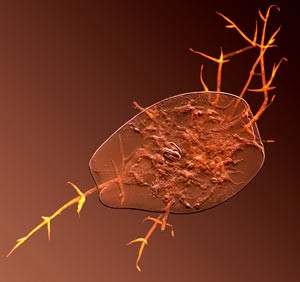Like little escape artists, rotifers elude their enemies by drying up and -- poof! -- they are gone with the wind
By Krishna Ramanujan
They haven't had sex in some 30 million years, but some very small invertebrates named bdelloid rotifers are still shocking biologists -- they should have gone extinct long ago. Cornell researchers have discovered the secret to their evolutionary longevity: These rotifers are microscopic escape artists. When facing pathogens, they dry up and are promptly gone with the wind.
"These animals have evolved a way to avoid parasites and pathogens by drying up and blowing away," said Paul Sherman, Cornell professor of neurobiology and behavior, who wrote the paper with lead author Chris Wilson, a Cornell doctoral candidate in Sherman's lab. After drying up, bdelloids come back to life when re-exposed to fresh water.
The Cornell study is featured on the cover of the Jan. 29 issue of Science.
Bdelloid rotifers (pronounced DELL--oyd ROW-tiff-ers) are tiny, freshwater invertebrates that have long puzzled scientists because, as completely asexual animals, they should have been extinguished by parasites and pathogens long ago in evolutionary time. Instead, the bdelloids have proliferated into more than 450 species.
Asexual animals like rotifers reproduce by cloning, and this makes for a fixed gene pool. Many scientists believe that the function of sex itself is to shuffle genes around. They theorize that the fresh genetic combinations that sex provides allow sexual animals to fend off relentlessly evolving parasites and pathogens. The discovery that bdelloids can desiccate and wisp away with the wind helps resolve the mystery of their ancient asexuality and success.
"It also helps answer one of the deepest puzzles in evolutionary biology -- why sex is nearly ubiquitous," said Wilson.
To study the bdelloids' adaptations, Wilson infected populations of rotifers with deadly fungi and found that they all died within a few weeks. He then tried drying out other infected populations for varying lengths of time before rehydrating them. He found that the fungi were far more sensitive to dehydration than the rotifers. The longer the infected populations remained dried out, the more successful they were at completely ridding themselves of fungi and eluding death.
In a second wave of experiments, Wilson placed dried, fungus-infected rotifers in a wind chamber. The scientists observed that the rotifers were able to disperse without the fungi and establish parasite-free populations. After just seven days of blowing around, there were as many fungus-free rotifer populations as there were after three weeks of dehydration without wind. So, by drying and drifting passively on the wind -- sometimes for hundreds of miles -- bdelloids can continually establish new, uninfected populations.
"These animals are essentially playing an evolutionary game of hide and seek," said Sherman. "They can drift on the wind to colonize parasite-free habitat patches where they reproduce rapidly and depart again before their enemies catch up. This effectively enables them to evade biotic enemies without sex, using mechanisms that no other known animals can duplicate."
The study was supported by Sigma Xi, the U.S. Department of Agriculture, Cornell and Cornell's Stephen H. Weiss Presidential Fellowship Fund.
Get Cornell news delivered right to your inbox.
Subscribe